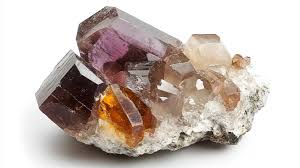
Zircon: The Timeless Flame of the Earth
A Crystal of Ancient Memory and Modern Mystery
Geological Origins of Zircon: Earth's Oldest Gem
Zircon is one of the most misunderstood yet geologically significant gemstones on the planet. Often mistaken for synthetic cubic zirconia due to the similarity in name, genuine zircon is an ancient, naturally occurring crystal that predates nearly all other minerals. In fact, some zircons have been dated at over 4.4 billion years old, making them among the oldest known substances on Earth.
Chemically, zircon is a zirconium silicate (ZrSiO₄), forming in tetragonal crystals that can exhibit high levels of brilliance and fire—traits typically associated with diamonds. The stone forms primarily in igneous rocks, though it can also be found in metamorphic and sedimentary deposits. It resists chemical alteration over time, which explains why zircons are invaluable to geologists studying the early history of the Earth.
Colour Variations and Origins
Zircon naturally occurs in a stunning variety of colours, from earthy browns and reds to radiant blues, greens, and yellows. The colours are typically influenced by trace impurities, heat treatment, or radiation exposure during formation. The most prized blue zircon often originates from Cambodia, Sri Lanka, and Myanmar, while golden and green hues are more commonly found in Australia and Tanzania.
Raw zircon crystals, especially in their natural prismatic form, possess a unique, rugged allure that appeals deeply to collectors and artisans alike. Unlike highly polished gems, these untouched forms retain a sense of Earth's original fire—raw, primordial, and mysterious.

Energetic Properties and Healing Significance
Zircon is often referred to as a stone of clarity, alignment, and balance. Many crystal practitioners regard it as a harmoniser of the physical and spiritual realms, anchoring light energy into the body while cleansing one’s auric field.
Key Healing Themes of Zircon Include:
-
Grounding & Protection: Due to its age and elemental structure, zircon is believed to hold deep Earth energies that protect and stabilise the aura.
-
Clarity & Mental Focus: Particularly in blue and clear forms, zircon is used to enhance mental clarity, relieve confusion, and stimulate intellectual pursuits.
-
Heart & Soul Alignment: Golden and peach-toned zircons are often used in spiritual work to reconnect with one's authentic desires and deeper soul path.
In the metaphysical community, zircon is sometimes described as a mirror to the soul, helping users reflect on their inner truths without the distortion of ego or illusion.
A Collector’s Treasure: Ancient Light in Mineral Form
Zircon's value as a collector’s mineral lies not just in its vibrant hues or optical brilliance but in its ancient origin. Each crystal tells a story of planetary evolution, of fire and transformation, and of the deep time that predates even the earliest life forms.
Natural, uncut zircons with defined crystal faces or matrix formations are highly sought-after in the mineral specimen community. These specimens often find their way into raw crystal jewelry pieces, where their natural geometry and earth-born energy are preserved rather than reshaped.

Zircon in Jewellery: The Radiant Elegance of Raw Form
Zircon has long been a favourite among lapidaries for its diamond-like sparkle and rich hues, but in recent years, a growing appreciation for its raw form has emerged. In the realm of mineral specimen jewellery, particularly within artisan circles, raw zircon is being embraced for its rugged beauty and energetic authenticity.
At Oryssia, we celebrate the natural geometry of zircon in its unrefined state — often set into crystal specimen rings or mineral specimen necklaces, where each piece is a tribute to Earth’s earliest whispers. The interplay of fractured lustre and earthy tones lends itself beautifully to handmade gemstone rings, especially when paired with darker metals or natural textures.
Compared to more commonly known stones like topaz or tourmaline, zircon is markedly more ancient, denser, and energetically grounding. Its raw form, less commercialised yet deeply storied, appeals to those seeking connection rather than decoration — jewellery that speaks, rather than simply shines.
Zircon Through the Ages: Myth, Magic, and Meaning
While zircon hasn’t featured heavily in classical mythology, it has historically been linked to protection and honour. In the Middle Ages, it was worn to promote restful sleep, repel evil spirits, and encourage prosperity. Blue zircon, in particular, was considered a talisman for travellers — its brightness thought to guard against deceit and danger.
In Vedic traditions, zircon (known as Jarkan) is linked to Venus and is sometimes recommended as a more accessible alternative to diamonds for strengthening love, creativity, and personal charm.
A Final Word on Legacy and Intention
Zircon is more than just an ancient gemstone — it is a mineral memory, a keeper of light from Earth’s deep past. In its raw state, it offers a tangible link between the spiritual and geological, between wearer and world.
For those drawn to raw crystal jewellery not merely for style, but for story, zircon offers a grounding presence and radiant soul. It invites you to wear something not crafted in a factory, but formed in the crucible of cosmic time.
We honour this stone through carefully curated jewellery pieces that uphold both energetic authenticity and natural beauty — quiet companions for inner clarity, presence, and connection.